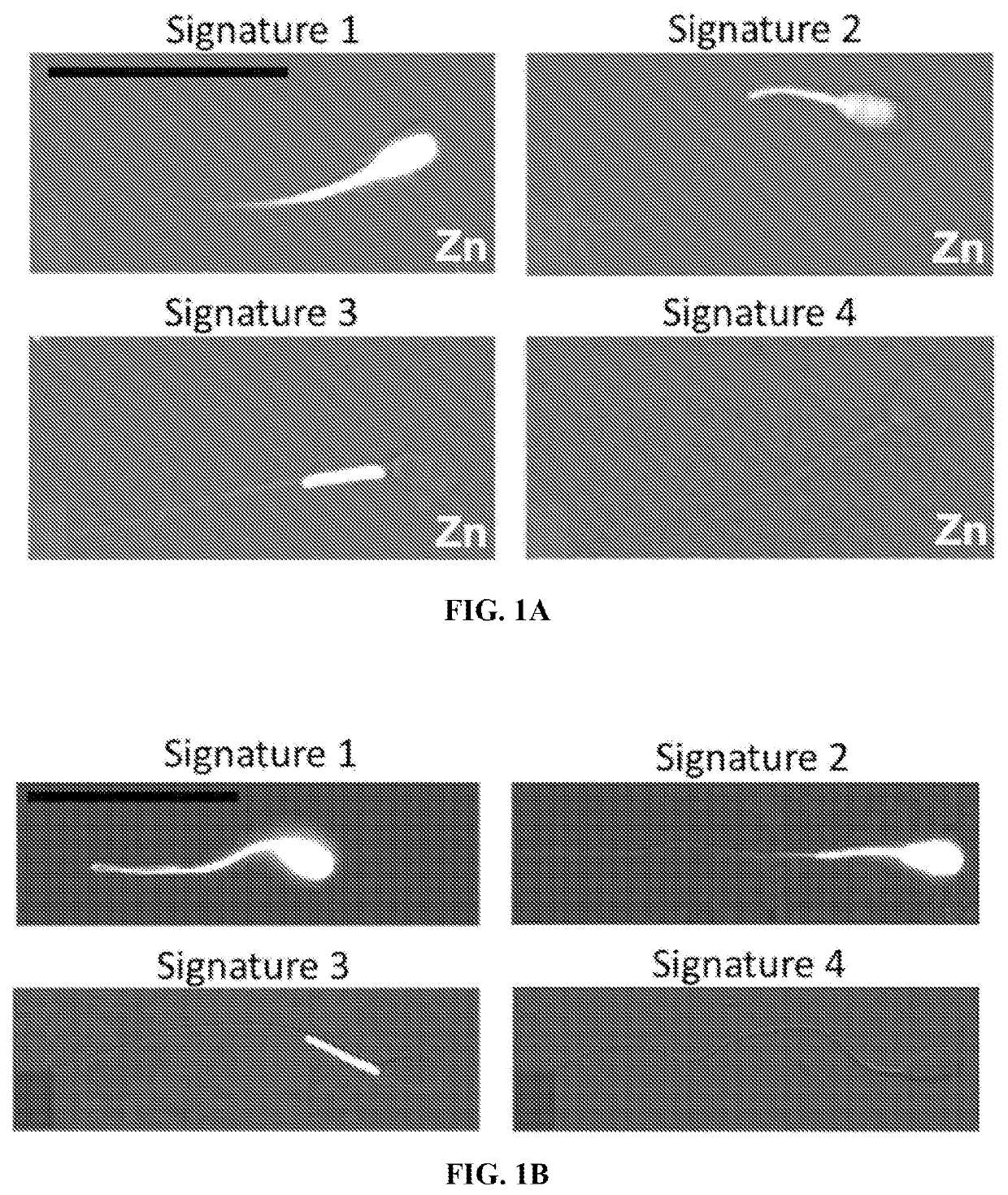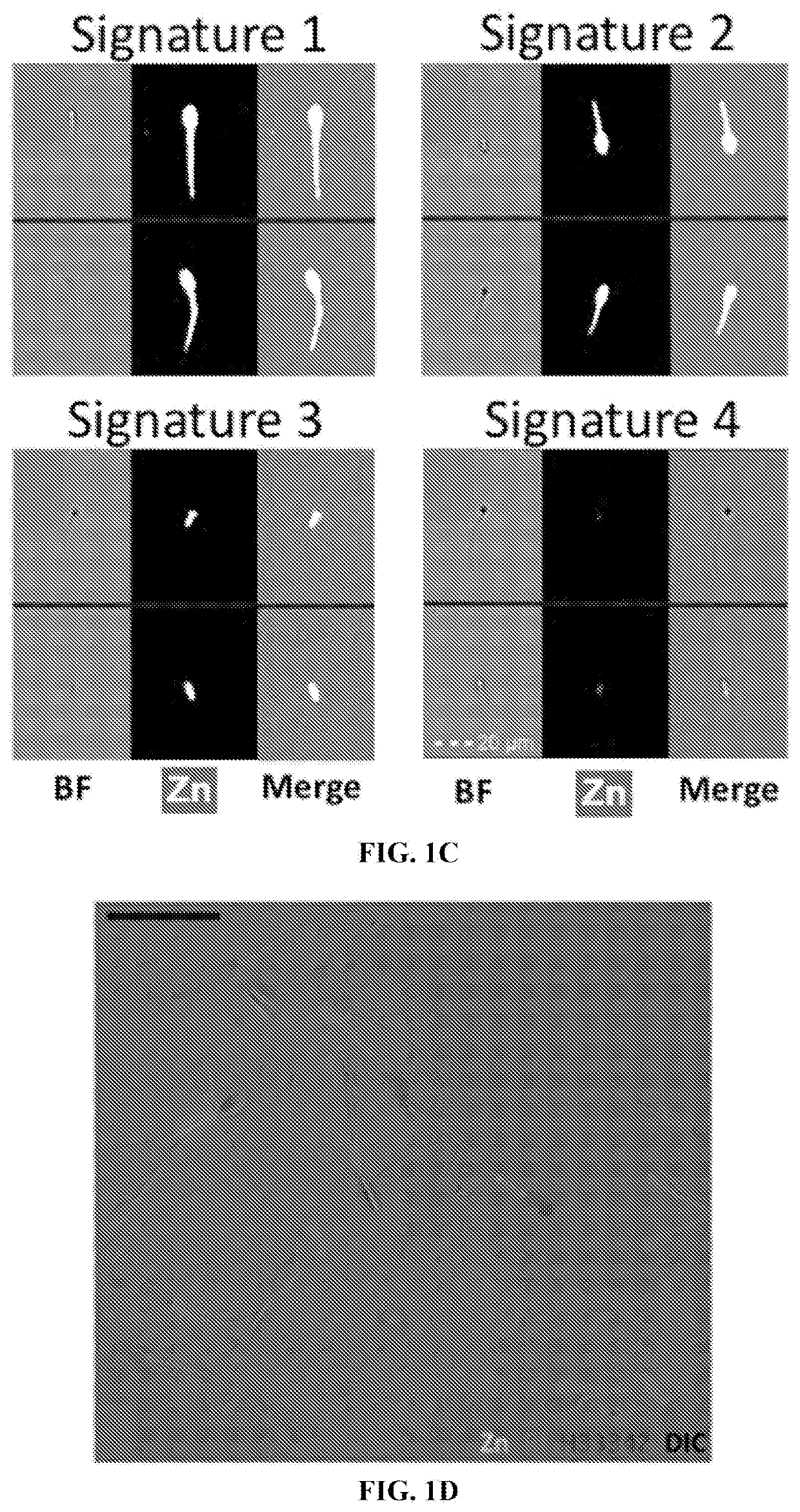Sperm fertility capacity test and sperm decapacitating supplement
a fertility capacity and sperm technology, applied in the field of sperm fertility capacity test and sperm decapacitating supplement, can solve the problems of rapid cell death, reduced fertility and quality of semen sample, etc., and achieve the effect of improving the fertility of spermatozoa
- Summary
- Abstract
- Description
- Claims
- Application Information
AI Technical Summary
Benefits of technology
Problems solved by technology
Method used
Image
Examples
example 1
Mammalian Spermatozoa Possess Four Distinct Zinc Signatures
[0094]Image-based flow cytometry (IBFC) and epifluorescence microscopy were used to trace the sperm zinc signature using Zn-probe Fluo Zin™-3 AM (FZ3), DNA stain Hoechst 33342, acrosomal remodeling detecting lectin PNA (Arachis hypogea / peanut agglutinin) conjugated to Alexa Fluor™ 647 (PNA-AF647), and live / dead cell, plasma membrane-integrity reflecting DNA stain propidium iodide (PI), which is taken up by exclusively by cells with a compromised / remodeled plasma membrane. The IBFC, which combines the fluorometric capabilities of conventional flow cytometry with high speed-multi-channel image acquisition, proved to be advantageous due to the high presence of Zn2+ in sperm cytoplasmic droplets and seminal debris, which otherwise would distort traditional flow cytometry results. A unique gating and masking strategy was developed to ensure unbiased data analysis (FIG. 2A-2D). Analyses were performed using the initial, pre-sperm ...
example 2
Zinc Signature is Indicative of Capacitation Status In Vitro
[0096]A drawback to commonly used 15 mM sodium bicarbonate in vitro capacitation media is rapid sperm death (as compared to in vivo sequential capacitation10), illustrated in the time course study by a shift to PI+ cell death flow cytometry gating (FIG. 4A, left panel) and rapid acrosomal modification (FIG. 4A, right panel). In the interest of emulating in vivo sperm life span and sequential capacitation as a fertility diagnostic method, a previously described capacitation medium11 was used. This medium had low (2 mM) sodium bicarbonate and increased sodium pyruvate (5 mM) and prolonged sperm viability (FIG. 4B, left panel) and elicited similar hyperactivation while achieving hallmark acrosomal modification (FIG. 4B, right panel).
[0097]Most spermatozoa in zinc signature 1 and 2 states had no capacitation-like acrosomal remodeling (93.0%±6.8% and 95.0%±2.6%, data presented as mean±s.d.; 10,000 cells analyzed per treatment, n...
example 3
26S Proteasome Modulates Zinc Signature Capacitation Shift
[0099]FIG. 7A shows representative zinc signature histograms as determined from IBFC analysis of sperm obtained or stored in various conditions (as indicated). FIG. 8A shows representative zinc signature histograms determined the same way from an independent second biological replicate. Fresh, ejaculated boar spermatozoa mostly had signature 1, (83.8%±3.1%; data presented as mean±s.e.m.; 10,000 cells analyzed per treatment, n=3 biological replicates; FIG. 7A). A small portion of spermatozoa incubated in non-IVC media for 4 hours at 37° C. progressed to signature 2 (FIG. 7A) as compared to spermatozoa in the same media incubated at room temperature to emulate the conditions of artificial insemination (FIG. 7A), suggesting that some spermatozoa undergo temperature-induced, early stage capacitation. When proteasome inhibitor MG-132 was added to IVC conditions to reduce sperm proteasome activity as previously described12,13, a si...
PUM
 Login to View More
Login to View More Abstract
Description
Claims
Application Information
 Login to View More
Login to View More - R&D
- Intellectual Property
- Life Sciences
- Materials
- Tech Scout
- Unparalleled Data Quality
- Higher Quality Content
- 60% Fewer Hallucinations
Browse by: Latest US Patents, China's latest patents, Technical Efficacy Thesaurus, Application Domain, Technology Topic, Popular Technical Reports.
© 2025 PatSnap. All rights reserved.Legal|Privacy policy|Modern Slavery Act Transparency Statement|Sitemap|About US| Contact US: help@patsnap.com



